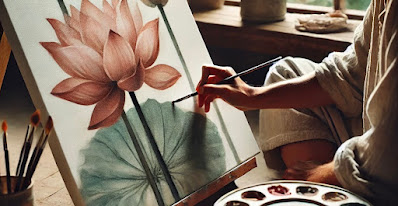ART AS MEDITATION: A Path to Creativity and Inner Peace
Art as Meditation: A Path to Creativity and Inner Peace
In a world of constant movement, where the pressure to be productive rarely slows, the mind becomes cluttered with endless thoughts and distractions. Many turn to meditation as a way to find stillness, but traditional methods—sitting in silence, focusing on breath—can be challenging for some. However, what if the same state of mindfulness could be achieved through creative practice?
Art, when approached with presence and intention, is more than self-expression—it is a form of meditation. The gentle repetition of a brushstroke, the steady movement of a pencil, or the layering of colors engages the mind in a way that draws attention away from daily worries and into the present moment. This process, often called a “flow state,” mirrors the benefits of meditation: reduced stress, heightened awareness, and a deeper connection to one’s inner self.
Letting Go of Perfection
One of the greatest barriers to creative practice is self-judgment. Many hesitate to create because they believe they lack skill or talent, fearing that their work will not be “good enough.” But meditation through art is not about producing a perfect image—it is about the experience itself. When we shift our focus away from the outcome and toward the process, we free ourselves from these limiting beliefs.
Think of a child drawing without inhibition, fully immersed in the movement of their hand across the page. There is no concern for perfection—only exploration, curiosity, and joy. When we create with this same openness, we allow ourselves to enter a meditative state where time dissolves, and the mind quiets. The act of making becomes its own reward.
The Healing Power of Art
Scientific research has long supported the benefits of both meditation and artistic expression. Engaging in a mindful creative practice can lower cortisol levels, reduce anxiety, and even improve cognitive function. The process of drawing, painting, or even doodling engages the brain in a way that promotes relaxation while simultaneously improving focus and problem-solving skills.
For those who struggle with traditional meditation, art offers an alternative—one that feels active yet grounding. Rather than struggling to empty the mind, we give it something to focus on, allowing thoughts to settle naturally. This is why many people find activities like knitting, woodworking, or even cooking to be calming—each requires attention to detail, rhythm, and repetition, which in turn creates a meditative experience.
Cultivating an Artistic Meditation Practice
Incorporating art into a mindfulness routine does not require expensive materials or professional training. A simple pencil and paper are enough to begin. The key is to approach the practice without expectation—no predetermined outcome, no pressure to create something “worthy” of being shared.
Some simple ways to begin include:
• Repetitive mark-making – Fill a page with repeating shapes, lines, or patterns. Focus on the rhythm of your hand and the sensation of the pencil on the paper.
• Blind contour drawing – Without looking at the paper, trace the outline of an object or face in a continuous line. This exercise sharpens observation skills while freeing you from self-criticism.
• Intuitive painting or coloring – Choose colors that resonate with your mood and allow your brush or pencil to move freely, without planning or overthinking.
• Slow sketching – Instead of rushing to finish, take time to truly observe what you are drawing, moving your pencil as slowly and deliberately as possible.
By practicing in this way, art becomes a tool for self-reflection, a way to slow down and reconnect with the present moment.
A Personal Journey with Art as Meditation
Through my own exploration of creativity as a mindfulness practice, I have come to see art as more than a skill—it is a path to self-discovery and peace. When we remove the expectation of perfection, we allow ourselves to simply be with our thoughts, emotions, and the movement of our hands. This shift in perspective can transform not only the way we create but the way we move through the world.
For those seeking a deeper understanding of this connection between creativity and meditation, I explore these ideas further in Art as Meditation. The book delves into the ways art can be used to cultivate presence, offering guidance and exercises for anyone—whether seasoned artists or complete beginners—who wishes to use creativity as a means of mindfulness. Art is not just something we do; it is a way of being, a practice that invites us to slow down, observe, and embrace the beauty of the present moment.
